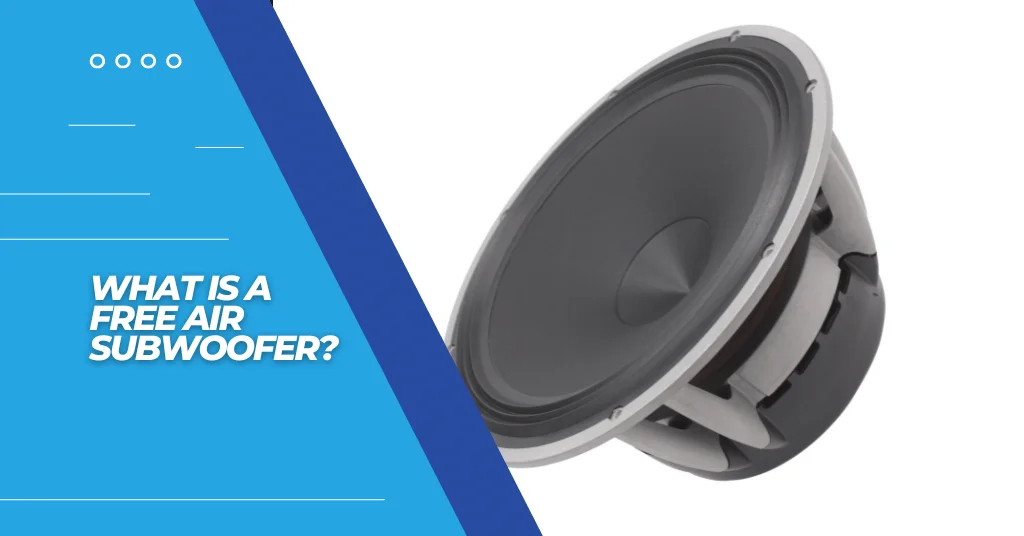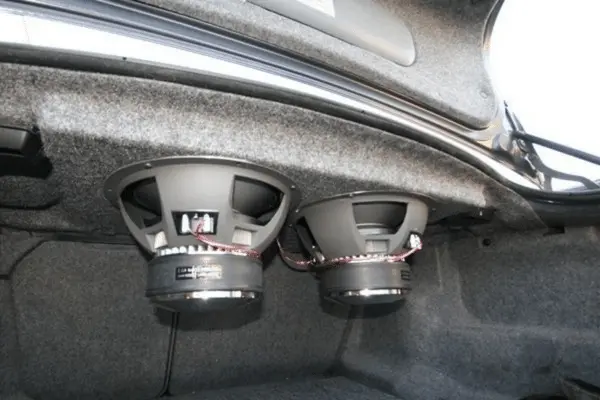What Is a Free Air Subwoofer?

There are a lot of subwoofer types in the market. However, the most discussed one is a free-air subwoofer. Some people still need to learn what is a free air subwoofer. As an Audio Expert, I will share my deep knowledge and experiences regarding free air sub. So, let’s get started already.
What Does Free Air Subwoofer Mean?

A free-air subwoofer is an enclosure-less speaker designed to be mounted directly onto the inner wall of a vehicle’s trunk or rear panel. This type of speaker does not require a traditional box-style enclosure but instead utilizes the rear space inside the car as its acoustic chamber. As such, it provides a less bulky and more efficient way of adding deep bass to a car audio system.
The free-air subwoofer is typically designed with an extended linear excursion and can produce higher sound pressure levels than most traditional subs. It also offers greater flexibility regarding placement within the vehicle since the size or shape of a box-style enclosure does not limit it.
How Does a Free Air Subwoofer Work?
The subwoofer cone sits within the vehicle’s existing trunk or hatch space, using the openings provided to enhance the low-frequency sounds it produces acoustically, resulting in a unique sound quality that is deep and loud. Like other traditional subwoofers, a free-air subwoofer also requires an amplifier to make its sound.
This amplifier provides the power and control necessary for the woofer cone to vibrate correctly within the vehicle’s cabin space, creating quality bass with minimal distortion. The free-air sub can receive input from an audio device, such as a CD or MP3 player, through this amplified connection.
Free Air Subwoofer Pros and Cons:
Before adding free air subwoofers, you should know their pros and cons. Knowing them can help you to choose the free air sub wisely.
Pros:
- Free-air subwoofers are much smaller and more compact than the traditional subs, making them easier to install in tight places or low-profile enclosures.
- As they don’t require an enclosure, they are often lighter and less expensive than sealed or ported models of the same size.
- Free-air subwoofers can produce great bass response if tuned correctly.
- They are a good solution for those who want to add extra bass without sacrificing trunk space.
- Free-air subwoofers are easy to afford as they don’t come up with a subwoofer box. So you can easily avail sub without burning your pocket.
Cons:
- Free air subs tend to be less efficient than sealed or ported models, requiring more power to reach their full potential.
- The lack of an enclosure means that sound waves can escape more efficiently, resulting in lower overall volume and clarity.
- Tuning a free-air subwoofer is more complex and requires knowledge of vehicle acoustics and proper tuning equipment.
- If not installed correctly, the bass response can suffer due to air leaks or other issues.
- They provide lesser and weaker bass quality than the enclosed subwoofers.
Overall, free-air subwoofers are an excellent option for those who want to add extra bass without sacrificing trunk space or spending too much money, but they require a bit more knowledge and effort to get the best sound. With the right equipment and tuning, they can produce an excellent bass response that will add an extra dimension to your music.
Free Air Subwoofer vs. Enclosed – Which One to Use?

When choosing between free-air subwoofers and enclosed ones, there are a few essential factors to consider.
Free air subwoofers, also known as infinite-baffle or IB subs, use the vehicle’s interior space as an enclosure, resulting in less weight and a more straightforward installation since you don’t need to build a sub-box.
On the other hand, an enclosed subwoofer uses a closed space, typically built into a subwoofer box, to resonate sound, resulting in more bass quality and higher sound pressure levels (SPL). Also, an enclosed subwoofer is a way to go if you want maximum sound performance and power handling capacity. Since it uses a closed space, the sound pressure levels ⁽¹⁾ can be significantly higher than free air subs.
Additionally, these enclosed subs typically have greater power handling capacity and are better suited for larger vehicles or systems that need increased bass output. Ultimately, the choice between a free-air subwoofer and an enclosed one comes down to personal preference.
The free-air subwoofer is the way to go if you need a compact solution that doesn’t require additional space. But if you want maximum sound performance and more power handling capacity, then an enclosed subwoofer is your best bet. Ultimately, it all comes down to what kind of system you want to create.
What Should I Look For in a Free Air Sub?
When selecting the best free-air subwoofer for your needs, there are a few essential factors to consider. The size and power of the subwoofer are two crucial elements that will determine how well the system can reproduce hard-hitting bass frequencies. Additionally, you’ll want to look at the vehicle’s acoustic type, efficiency rating, impedance, and sensitivity.
1. Size and Power:
The size of the free-air subwoofer is essential, as it will determine how much power it can handle. Generally speaking, more giant subs can produce deeper bass notes than smaller ones. On the other hand, if you’re looking for more accurate, more efficient sound waves, you should consider a smaller sub. Additionally, the subwoofer’s power rating will determine how loud it can get, so make sure you pick one rated for your needs.
2. Efficiency Rating:
Efficiency rating refers to how much power the subwoofer can handle relative to size. This can range from very low to very high, and you should consider it when selecting which free air subwoofer you’ll buy. Generally speaking, the higher the efficiency rating, the better your subwoofer will sound.
3. Impedance:
Impedance measures how much electrical resistance the subwoofer has. You can measure it in ohms (Ω). Generally speaking, you’ll want to select a subwoofer with the same impedance rating as your amplifier or receiver.
4. Sensitivity:
Sensitivity determines how well the subwoofer reproduces more focused bass frequencies and is measured in dB/Watts ⁽²⁾. Higher sensitivity ratings will generally produce better sound quality than lower ones, so select a subwoofer with the highest sensitivity rating.
Different Types of Installation for Free-Air Subwoofers:
The available space in car audio is essential in finding installation options for free air subwoofers. You can quickly install free air subs in a car’s cargo area, trunk, rear deck, or hatchback. You can easily do this by drilling holes in the side panel and running the wires through them.
Another option is to mount the free-air subwoofer on the rear deck. You can quickly execute this method by removing the back seat and attaching a mounting bracket to secure the subwoofer. It’s important to note that this approach requires more space since it takes up more room than when installing the free air subwoofer in the cargo area or trunk. Additionally, you can also prefer small deck installation.
1. Car’s Cargo Area:
This type of installation requires some modifications in the car audio before proceeding. This is because you must make the car interior an enclosure for the free-air subwoofer to work correctly. It involves cutting a hole in the vehicle’s cargo area and installing a mounting ring so that the subwoofer can securely attach to it. You must cut the hole slightly larger than the mounting ring to allow for some movement of the subwoofer. The size and shape of the hole will depend on the model of the free-air subwoofer that you want to use.
2. Installing Free Air Subwoofers in Doors:

This type of installation is often referred to as “flush mount” or “flush mount subwoofers,” meaning the subwoofer is secured directly to the door panel rather than being mounted in an existing enclosure. The mounting ring for this installation is usually glued to the door panel, then sealed with silicone or epoxy. However, you can also replace the door’s speakers with suitable free-air subs. That’s the most efficient way you can install them.
3. Mounting The Free Air Subwoofer on the Rear Deck:
This installation requires a rear deck with enough space to accommodate both the subwoofer and amplifier. Depending on your preference, the mounting method can be either permanent or non-permanent. You will need to drill through the deck to install the subwoofer’s mounting screws. Once everything is secured, connect the power, ground, and speaker wires to the amplifier.
Tips to Choose a Free Air Subwoofer:
- Know what kind of sound you’re looking for: When searching for a free-air subwoofer, you must know the type of sound you want. Are you looking for deep and great bass notes? Do you want more punchy mid-range frequencies? Understanding the kind of sound that you’re after will help narrow down your options.
- Consider the size of your vehicle: The size of your car is also essential when choosing a free-air subwoofer. You may opt for a smaller, more efficient model if you have a small car. On the other hand, if you’re driving an SUV or pickup truck, go for a larger subwoofer that can produce more powerful sound waves.
- Think about power handling: When selecting a free-air subwoofer, it’s crucial to consider how much energy you need helping you ensure that your sound system is adequately powered and can produce the type of sound you’re looking for.
- Look at the frequency range: The range of a free-air subwoofer is also essential as it determines what kind of sound the unit can produce. Be sure to look at the frequency range before purchasing to know how much tight bass or treble the subwoofer can make.
General FAQs
Can You Put a Free Air Subwoofer in a Sealed Box?
The short answer is no; you can’t put a free-air subwoofer in a sealed box. Free-air subwoofers are designed for open-air installations, not within an enclosure. Sealed enclosures provide the tight bass response and maximum efficiency for a speaker system but require additional power from an amplifier. Without the extra power, the subwoofer cannot produce any sound.
Additionally, a sealed box does not allow for an even distribution of air pressure which a free-air subwoofer requires to operate correctly. Using a free-air subwoofer in a sealed enclosure could damage the speaker. When used this way, the woofer cannot move enough air to produce sound, decreasing efficiency and potentially burning out the speaker’s voice coil.
How Do You Know if a Subwoofer Is Free Air?
Free-air subwoofers are designed to help you maximize the bass power of your car audio without taking up too much space. But how do you know if a separate subwoofer is free air? A few key features tell you whether or not a subwoofer qualifies as free air.
The most important feature is the enclosure. Free air subwoofers do not require a section – instead, they are designed to be mounted directly to a wall or inside the trunk of your car. They have small magnets and lightweight frames that enable them to fit into tight spaces without taking up too much room.
What Is a Fresh Air Subwoofer?
A Fresh Air subwoofer is a type of speaker designed to be placed outside of traditional enclosures. It’s made with a weatherproof cabinet that can stand up to the elements, allowing you to enjoy your music outdoors without worrying about it getting damaged.
Can You Use a Subwoofer Without Sub Box?
The short answer is yes; you can use a subwoofer without a sub-box. Many people choose to use their DIY boxes or no sub-box as they don’t want the extra bulk and weight of having an enclosure. Although this is possible, you should note that if misused, you could damage your subwoofer.

As someone who has been running four 10” subs “free air” since the mid 1980’s, I have some things you may wish to consider.
In your Free Air “Cons” you say they require more power than a sealed sub. I disagree. A FA sub is free to convert electrical power/magnetic field energy into cone movement. A sealed sub does this but must ALSO compress the air in the cabinet. This force takes energy from the cones movement and INCREASES energy consumption. This is why sealed subs must be built more robust to resist this fight. Now it can be said that it can improve frequency response but it does efficiency no favors.
Your comments on power handling capacity are very popularly espoused but consider this. The whole purpose of audio drivers of any sort is to create sound waves. Soft, loud, high, low whatever the case may be. Their primary, secondary or any other purpose is NOT simply to consume power. Yes, it takes power to do work but many people’s misconception is that POWER is the be all end all for successful sound level. I will take a 100w woofer with 91 db sensitivity over a 1000W woofer with a 87db sensitivity every day of the week. It is much less costly to buy and wire a 100w amp than a 1000W amp. Not to mention the tax on your electrical system in a car audio environment.
Now I have never actually killed a sub in nearly 40 years. Let’s address the physical limitations that can kill subs. A Free Air sub does not have “compress” air as mentioned above. Assuming amplifier power and signal quality is NOT a factor, this means that excessive signal input will cause the voice coil to drive itself beyond the magnetic field of the magnet. This creates distortion due to non-linear movement. Most people will hear this and dial back the volume. Also, many FA subs have vented pole pieces which use the cone movement to cool the VC. This generally means FA subs can be driven just below Xmax for extended periods of time without failure. Now let’s try this with a sealed sub in an enclosure. No cooling from a vented pole piece. Compressing the air in the cabinet requires additional force to be generated electrically resulting in additional I squared R losses. Add to this, the air molecules in the enclosure are subject to being heated by the energy pumped into them during long periods of play. This heat is eventually radiated into the walls of the enclosure but wood and carpet are not good heat transfer mediums. Heat build up is a distinct possibility. Given that we stay below Pmax with no distortion, a sealed sub subject to long play durations at volume are more subject VC burnout. (Been there, done that).
You suggested FA in door panels and/or side panels. Unfortunately, this has its limitations due to the effect of the back wave interaction with the interior door panels causing cancellation at some frequencies. The closest one can come to Free Air is the use of the trunk via rear package shelf or the rear seat backs. Not really practical for trucks, SUVs or convertibles.
One other unmentioned advantage of FA vs. sealed. The ability the completely secure the frame of the subwoofer to the STRUCTURE of the vehicle. We humans can both hear and feel bass. When we can take advantage imparting energy into the structure of the vehicle we can have more bass that we can feel in the seat. A carpeted box, regardless of its weight, is still basically solely depending on the sound waves produced via air movement.
Sorry for the long post but not everyone considers the real world PHYSICS of what producing sound takes and simply parrot what they learn on the internet.
Thanks Bill N. for putting the time and effort to comment.
I hope that the readers will benefit from your experience.
I can second Bill strongly regarding the installation of a FA sub in the rear parcel shelf. I only have a 10″ sub with a Qts > 0.6 and RMS power rated on 500 Watt only. Not really a huge figure. Still this setup gives me quite a decent both deep and kick bass. If you listen to “music”, not an earth quake, the FA is really an alternative to go, provided the right sub. And I forego not much space to none in the trunk.